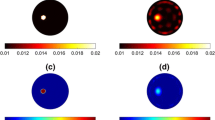Abstract
Diffuse optical tomography (DOT) is an emerging non-invasive optical imaging technique, which has a promising application in breast cancer detection and diagnosis. However, the conventional image reconstruction algorithm in DOT is time-consuming and easy to error when recovering the distribution of optical parameters within the complete tissue. In this paper, we present an end-to-end reconstruction algorithm for DOT based on a deep convolutional encoder-decoder architecture, which consists of a data processing part and a convolutional encoder-decoder net. Its effectiveness was evaluated using simulation data. The results show that the overall quality of our method is significantly improved compared with the traditional algorithm based on the FEM method, the single inclusion deviation is reduced by 150% compared with the traditional algorithm, the standard deviation is reduced by 50%; multiple inclusions deviation is reduced by 100% and the standard deviation by 38.7%.
Access this chapter
Tax calculation will be finalised at checkout
Purchases are for personal use only
Similar content being viewed by others
References
World Health Organization. World Cancer Report. Cancer research for cancer prevention. Lyon WHO, p. 253 (2020)
Choe, R., et al.: Differentiation of benign and malignant breast tumors by in-vivo three-dimensional parallel-plate diffuse optical tomography. J. Biomed. Opt. 14(2), 024020 (2009)
Fang, Q., et al.: Combined optical and X-ray tomosynthesis breast imaging. Radiology 258(1), 89–97 (2011)
Mastanduno, M.A., et al.: MR-guided near-infrared spectral tomography increases diagnostic performance of breast MRI. Clin. Cancer Res. 21(17), 3906–3912 (2015)
Chae, E.Y., et al.: Development of digital breast tomosynthesis and diffuse optical tomography fusion imaging for breast cancer detection. Sci. Rep. 10(1), 13127 (2020)
Feng, J., et al.: Addition of T2-guided optical tomography improves non-contrast breast magnetic resonance imaging diagnosis. Breast Cancer Res. 19(1), 117 (2017)
Zhu, Q., et al.: Assessment of functional differences in malignant and benign breast lesions and improvement of diagnostic accuracy by using US-guided diffuse optical tomography in conjunction with conventional US. Radiology 280(2), 387–397 (2016)
Choe, R., et al.: Diffuse optical tomography of breast cancer during neoadjuvant chemotherapy: a case study with comparison to MRI. Med. Phys. 32(4), 1128–1139 (2005)
Sajjadi, A.Y., et al.: Normalization of compression-induced hemodynamics in patients responding to neoadjuvant chemotherapy monitored by dynamic tomographic optical breast imaging (DTOBI). Biomed. Opt. Express 8(2), 555–569 (2017)
Tromberg, B.J., et al.: Predicting responses to neoadjuvant chemotherapy in breast cancer: ACRIN 6691 trial of diffuse optical spectroscopic imaging (DOSI). Cancer Res. 76(20), 5933–5944 (2016)
Chuang, C.-C., et al.: Diffuser-aided time-domain diffuse optical imaging. In: 2014 International Symposium on Computer, Consumer and Control, Raleigh American, p. 929 (2014)
Medhi, B., Kandhirodan, R.: Image sensor based diffuse optical tomographic system. In: 2019 International Conference on Signal Processing and Communication (ICSPC-2019), Coimbatore, India, p. 209 (2019)
Yoo, J., Heo, D., Kim, H., Wahab, A., et al.: Deep learning diffuse optical tomography. IEEE Trans. Med. Imaging 39(4), 877–887 (2020)
Deng, B., et al.: FDU-net: deep learning-based threedimensional diffuse optical image reconstruction. IEEE Trans. Med. Imaging (2023)
Dehghani, H., Eames, M.E., Yalavarthy, P.K., et al.: Near infrared optical tomography using NIRFAST: algorithm for numerical model and image reconstruction. Commun. Numer. Methods Eng. 25(6), 711–732 (2008)
Kumar, Y.P., Vasu, R.M.: Reconstruction of optical properties of low-scattering tissue using derivative estimated through perturbation Monte-Carlo method. J. Biomed. Opt. 9(5), 1002–1012 (2004)
Heiskala, J., Kotilahti, K., Nissila, I.: An application of perturbation Monte Carlo in optical tomography. In: Proceedings of the 27th Annual International Conference of the IEEE Engineering in Medicine and Biology Society (2005)
Heiskala, J., Pollari, M., Metsaranta, M., et al.: Probabilistic atlas can improve re-construction from optical imaging of the neonatal brain. Opt. Express 17(17), 14977–14992 (2009)
Boas, D.A.: Diffuse photon probes of structural and dynamical properties of turbid media: theory and biomedical applications. University of Pennsylvania, Philadelphia (1996)
Nisa, W., et al.: Continuous wave diffuse optical tomography for imaging defect in agricultural. In: 2018 2nd Borneo International Conference on Applied Mathematics and Engineering (BICAME), Balikpapan, Indonesia, p. 123 (2018)
Acknowledgments
This paper is supported by the Project for the National Natural Science Foundation of China (82171992, 62105010).
Author information
Authors and Affiliations
Corresponding author
Editor information
Editors and Affiliations
Rights and permissions
Copyright information
© 2023 The Author(s), under exclusive license to Springer Nature Singapore Pte Ltd.
About this paper
Cite this paper
Li, Y. et al. (2023). A Self-supervised Learning Reconstruction Algorithm with an Encoder-Decoder Architecture for Diffuse Optical Tomography. In: Yongtian, W., Lifang, W. (eds) Image and Graphics Technologies and Applications. IGTA 2023. Communications in Computer and Information Science, vol 1910. Springer, Singapore. https://doi.org/10.1007/978-981-99-7549-5_2
Download citation
DOI: https://doi.org/10.1007/978-981-99-7549-5_2
Published:
Publisher Name: Springer, Singapore
Print ISBN: 978-981-99-7548-8
Online ISBN: 978-981-99-7549-5
eBook Packages: Computer ScienceComputer Science (R0)




